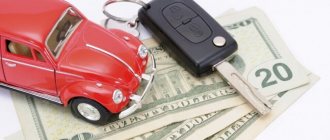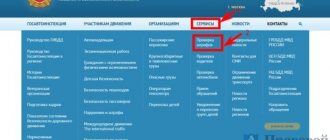What does it mean to seize a car?
For most inexperienced car owners, car seizure, ban or restriction of registration actions are identical concepts. However, from a legal point of view they are different.
The restriction prevents the implementation of ownership rights (or other rights) in relation to property. This measure can be used when dividing a car between spouses during a divorce, pledging a vehicle as collateral, etc.
A prohibition should be understood as a decision that prevents the owner of the property from performing a specific action or series of actions. For vehicles, a ban on registration actions is most often used. This measure can be used if there are debts on alimony, loans, fines and in other situations.
The concept of arrest is much broader than the previous ones. In accordance with Article 51 of the Federal Law “On Enforcement Proceedings” (FZ-229 of October 2, 2007), this measure provides for an inventory of property and a ban on performing absolutely any actions with it.
Also read: All about traffic police restrictions on cars
Checking for restrictions
Beware of car purchases that are subject to restrictions. We have prepared a special material in which we talk about restrictions on cars and what they can mean for the new owner.
In what cases are restrictions imposed:
- if the customs authorities have suspicions that the vehicle was cleared through customs under a “gray” scheme;
- if the vehicle is the subject of a dispute in court;
- if the owner of the car is obliged by court to pay a bailiff a certain amount of money.
Also read: What are the risks of buying a car that is seized?
You can check your car for restrictions on the official website of the traffic police. To do this, you need to know the VIN code or chassis number.
The check can also be carried out through the official website of the bailiffs. To do this, you need to know the owner’s passport details, SNILS or TIN.
Users of the Autocode service can learn about restrictions
, imposed on the vehicle, according to the license plate number.
Who has the right to seize a car and in what cases?
This procedure can be initiated by a decision:
- court when satisfying the claim of any organization or government agency (bank, social security department, etc.);
- customs authorities;
- bailiffs.
There are many reasons why a car is seized. The most common of them are unpaid utilities, overdue loans, debts for alimony or traffic police fines. Also, punitive sanctions can be initiated for non-payment of taxes or for violations of customs clearance of a car (for example, the owner, in order to avoid paying a fee to the state treasury, imports it from abroad for spare parts, etc.).
Checking your car for fines
There is always a possibility of purchasing a car with outstanding fines. Often, sellers themselves do not know about the debts to the traffic police, but sometimes they deliberately withhold information so that all debts fall on the new owner.
Of course, if you buy such a car, you cannot be forced to pay these fines; this is the responsibility of the former owner. However, there are situations when, due to non-payment of fines, registration restrictions are imposed on the car. In this case, the new owner will not be able to register the car.
To identify the presence of fines, you can use the following services:
- official website of the traffic police;
- Autocode service.
To check a vehicle through the official website of the traffic police, you need to know both the license plate number of the car and the number of the registration certificate. To check using the Autocode service, you just need to know the license plate number of the car. At the same time, from the report, in addition to the history of fines, you will learn data on mileage, technical inspections, compulsory motor liability insurance, restrictions and much other important information.
Seizure procedure
The seizure of a car by bailiffs is carried out in the manner provided for in Articles 64 and 68 of the Federal Law “On Enforcement Proceedings”. FSSP employees are required to present the owner with the relevant resolution and draw up an inventory of the property.
An act of seizure must be drawn up and documents for the car must be confiscated: PTS and registration certificate (in this case, the presence of two witnesses is required). The act of seizure specifies the following parameters:
- car color;
- license plate;
- body and engine numbers (when it comes to trucks, the chassis number is additionally indicated).
In addition, the document must mention external and internal defects of the car.
Then the issue of transferring the vehicle for storage is decided. An outside person or organization with which the FSSP has concluded a corresponding agreement may be appointed responsible for the safety of the car. However, quite often the seizure procedure is not carried out. In this case, the owner of the car or one of his family members is appointed responsible for storage.
It should be remembered that using a seized car, in accordance with Art. 86 of the Federal Law “On Enforcement Proceedings”, it is impossible without the written consent of the bailiff. Otherwise, the matter may lead to criminal liability.
By the way, you most likely will not receive permission from the bailiff, since cars belong to the category of property that can suffer significant damage during operation (for example, in a traffic accident). Accordingly, the cost of the seized transport will decrease.
The lien on the car will be removed after the debt is paid off. Otherwise, it may be put up for auction.
Verification of documents
Before purchasing a used car, you should definitely check the following documents:
- vehicle registration certificate;
- PTS;
- seller's passport.
You must make sure that the PTS contains all the necessary stickers and marks. Why is it worth doing this? If there are marks, then the body numbers are interrupted, unreadable or simply hard to see.
It is also worth taking into account the originality of this document. If the owner has issued a PTS to the client, then everything is in order, but if it is a duplicate, then there may be other options. For example, a duplicate can be issued if there is no longer room on the original to include the owners. A duplicate is also issued if the original is lost. Before purchasing, you should definitely check with the seller who is presenting the duplicate about the reasons for this.
There is no need to rush into refusing to purchase for this reason, because it is still possible to check the car’s history through a special service. If the seller’s words and the service data match, then you don’t have to refuse the purchase. If the owner has hidden information about the previous owners and claims that he is the only one, then you should refuse the deal with him.
It is definitely worth checking the owner’s passport data with those indicated in the PTS. Even if there is a small error or typo, problems may arise in registering the car.
In what cases can the seizure of a car by bailiffs be challenged?
According to current legislation, the arrest procedure cannot be carried out if the car belongs to:
- one of the debtor’s family members (for example, the husband’s car should not be seized for the wife’s debts or vice versa);
- a disabled person, and he needs it for movement;
- a debtor whose work is directly related to the use of a car he owns (taxi, freight transportation, etc.).
If the owner of the vehicle fits one of the above categories, but the arrest was still made, it’s time to go to court.
Testing for work in a taxi
"Autocode" provides its users with the opportunity to check whether the vehicle is registered with official taxi services.
If a service check gives you such information, then it is better to refuse the purchase. Such a machine, even if it is relatively young, has most likely practically exhausted its service life. That is, you will face constant repairs that require large financial investments.
Also read: A car after a taxi: how to recognize it and whether it’s worth buying
What are the risks of buying a seized car?
Some owners, after a car has already been seized, try to get rid of it. And there are buyers for such vehicles: they are attracted by the relatively low cost. If you make such a transaction knowingly, remember that you will not be able to legally complete the purchase. All seized vehicles are included in the traffic police database.
Often, the buyer simply does not know that the car sold to him is under arrest. Having contacted the traffic police, the newly-minted owner is denied registration of the vehicle. That is, you seem to have a car, but he cannot use it legally.
In this situation, there are several options:
- Try to get punitive sanctions lifted. True, this is only possible in a situation where the seizure occurred later than the conclusion of the purchase and sale agreement for the vehicle.
- Try to negotiate peacefully with the seller to terminate the transaction and return the money by sending him a corresponding claim in writing. The effectiveness of such actions is very doubtful, since the owner of the car perfectly understood the illegality of his act, which means that persuasion most likely will not work on him. Often the seller simply hides, turns off the phone and does not want to get in touch.
- If the second option does not work, you will have to file a claim to terminate the transaction and return the funds. The buyer has every right to do this in accordance with Article 460 of the Civil Code of the Russian Federation. Here you need to remember the following: if the transaction amount is less than 50 thousand rubles. - you should contact the magistrates, if more - the district court.
Practice shows that in the vast majority of cases your claim will be satisfied, but be prepared for the fact that the legal proceedings will take about 2 months.
An important point when drawing up a purchase and sale agreement (SPA) is to indicate the actual cost of the car. Often, by mutual agreement, a much smaller amount is fixed on paper. At the same time, the buyer should understand that if, for example, he actually paid 500 thousand rubles for the purchase, and the contract indicates half that amount, it will be very difficult to return the money in full. After all, the court does not need words, but documented evidence.
The essence of car seizure
The seizure of a vehicle is a series of measures taken by government agencies (bailiffs or customs services) regarding a specific vehicle. This is done to prevent or eliminate the consequences of illegal fraud on the part of the owner that are associated with the operation of the car. When a vehicle is seized, a ban is imposed on its sale, transfer of ownership to third parties, and so on. The decision to seize the car is made by the court. The owner of the vehicle is notified of this by informing the court officials.
A word from the experts
Yulia Kombarova, General Director of Legal Bureau No. 1:
“In all standard contracts for the purchase and sale of property, including cars, there is a clause that states: “The seller guarantees that the car is not pledged, that third parties have no claims to it, and the seller also guarantees that it has no signs of and bankruptcy cases filed.” This clause of the contract protects the buyer, and places full responsibility for the circumstances of the transaction on the seller. Therefore, in the event of detection of arrests imposed on the item of purchase, after concluding a sales contract and transferring money, the buyer has the right to invalidate the contract, receive the money back and return the car.
Proving the good faith of the acquirer is, of course, a time-consuming legal process. But for the services of a representative and other legal expenses can be recovered from an unscrupulous seller in court. It should be noted that if you win a lawsuit, you will not be able to get money right away. Most likely, you will have to contact the bailiff service, and if the debtor is in bankruptcy proceedings, then submit your claims to the register of creditors of the debtor in the bankruptcy case.”
Valerik Vardanovich Galstyan, senior partner of the law firm:
“In such a situation, things can develop in two ways:
- If the contract for the sale and purchase of a vehicle was executed before the seizure, then the new owner has the opportunity to try to lift the seizure in court by proving that he was a bona fide purchaser, and at the time of the seizure the vehicle was not owned by the seller.
- If the purchase and sale agreement was executed after the seizure, the car will be confiscated from the new owner, since the seizure is a restriction on taking actions to alienate property. Therefore, the seller did not have the right to sell the property under arrest.
In the second case, the new owner has every right to terminate the purchase and sale agreement concluded with the seller and demand the return of the funds paid by him.”
Checking a car for theft
If you purchase a used car that is listed as stolen, there is a chance that you will have to sue the owner who has turned up. In 85% of such situations, the judge obliges the new owner to return the vehicle to its real owner. In this case, you will lose not only the car, but also the money spent on it. It is unlikely that you will be able to get your money back from a fraudster who hid the fact of the theft during the transaction.
Also read: How stolen cars are sold and how to check for wanted cars
To check, you can use the following methods:
- check through the official website of the traffic police;
- together with the seller, deregister the car (if the car is stolen, the seller will not be able to carry out this action).
You can also use Autocode and get a more detailed report about the car in just 5 minutes.









